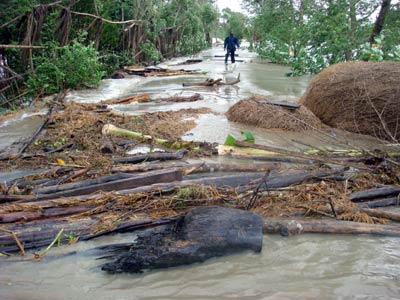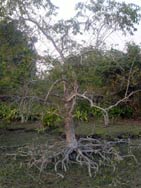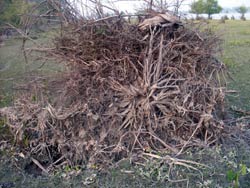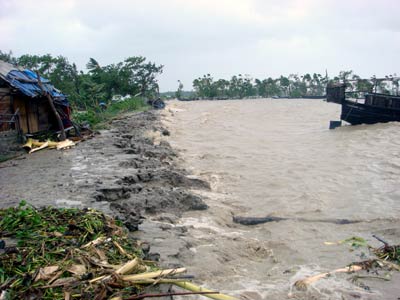 |
Md Nadiruzzaman argues that we need to learn more from past experience of the impact of natural hazards if we are to deal effectively with these events in the future. |
| The author is is a doctoral fellow with the Institute of Hazard and Risk Research at Durham University in the United Kingdom. | |
Bangladesh has been subjected to frequent natural disasters in many forms, particularly cyclonic storms and tidal surges. From 1797 to 1998, 67 major cyclone storms and tidal surges have been reported, indicating that Bangladesh is prone to a major cyclone on average every three years. The nation experiences 53 per cent of the world deaths from tropical cyclones. The 1970 Bhola cyclone, which killed 500,000 people, has been the single deadliest event so far. From known history, there are eight records of six-figure death tolls from cyclones and tidal surges and five of them occurred in Bangladesh.
 |
|
Flooding two miles from the Baleshwar River after
the tidal surge created by cyclone
Aila on May 25th 2009
© Md Nadiruzzaman |
Cyclone Sidr struck Bangladesh on November 15th 2007 and caused severe devastation and loss of life. Sidr left 3500 dead and thousands missing. Two million people were displaced and 1.2 million homes were damaged. Sidr was the most powerful cyclone to affect Bangladesh since a storm of similar strength on April 29th 1991 killed 138,000 people on the Chittagong coast.
On the morning following Sidr's devastation, Mr Alamgir, who lives in the village of Royenda in the local growth centre in Gabtola in southern Bangladesh, set off on foot at the dawn to his village and arrived at dusk. Though it was just ten miles away, the main obstructions on the roads were uprooted trees. This was the same problem that dissuaded many people from leaving their homes to take refuge at their nearest cyclone shelter. A number were killed by falling trees and flying debris. It is really a great wonder for me that, while the whole world is campaigning for a greener world, this became an irony at Gabtola, the area most affected by Sidr as it tracked along the Baleshwar River (view map).
Interestingly, most of the uprooted plants were not local species. They were imported from different parts of Bangladesh more than two decades ago as a part of a social forestry programme. Linked with a poverty alleviation programme, the programme strove to inspire peasants nationwide to plant timber trees like chamble, mahogany, shirish, rain tree, and so on, so that the peasants can have petty cash by selling mature timber.
Several small and medium entrepreneurs responded to this campaign, which gave rise to a significant number of plant nurseries all over the country. These nurseries tried to maximize their profit by increasing their productivity in a limited space. This led them to cut the main root of the growing plants so that they could be grown on compost in a small plastic container. There was also a demand by farmers to have the plants at and above a certain height so that their cattle could not reach the top of those plants. However, while these plants grew bigger, their roots expanded only horizontally in loose alluvial soil because of this severing of the tap root at a very early stage. It was these plants that were unable to withstand high velocity winds and they became deadly airborne missiles in the high winds of Cyclone Sidr.
  |
|
A tree with its main root intact survived the storm
(left) while another fell down (right)
© Md Nadiruzzaman |
After Sidr, there was direct and indirect support from many international non-governmental organizations (NGOs) and donor agencies. Despite knowledge of the potential risks of growing plants without roots, the same quality of plants was distributed to the victims.
By way of explanation, the NGOs blamed their donors for allocating insufficient money to buy appropriate plants. But in my conversations with donors, they claimed a very good cooperation with their partners, especially in regard to funds. The government runs a monitoring device by empowering local government executives to authorize and approve any development project, but they remain silent as retired former bosses, who are likely to have very good connections with the high-rank government executives, have joined the NGOs as consultants. Thus, the issues remain unaddressed.
 |
|
House of landless people on the Baleshwar River
embankment
© Md Nadiruzzaman |
Over the past couple of decades, natural hazard events have increased dramatically and, in 2004-5, climate-induced casualties have increased by 18 per cent over the world as a whole. Statistical, satellite and observational data suggest that both the intensity and magnitude of storms will increase in the future. There are several issues like our engineered plants that need to be understood and addressed. Otherwise, what we have learnt from our lived experiences will have no use.
Further information
Md Nadiruzzaman, Institute of Hazard and Risk Research, Geography Department, Durham University, Science Site, South Road, Durham DH1 3LE, United Kingdom. Fax: +44-191-3341801 Email: md.nadiruzzaman@durham.ac.uk. Web: www.dur.ac.uk/ihrr/.
On the Web
The Tiempo Climate Cyberlibrary lists selected websites covering climate change and Bangladesh and climate change and natural disasters.